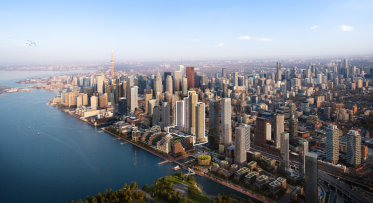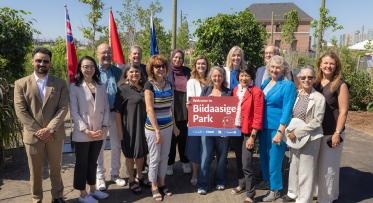Three Ingredients of Canada’s First Destination Playground

POSTED: DECEMBER 9, 2022
BY: MATTHEW URBANSKI, MICHAEL VAN VALKENBURGH ASSOCIATES (MVVA), INC., LANDSCAPE ARCHITECTS
In This Blog:
- Port Lands Flood Protection will create big new parks on Toronto’s downtown waterfront.
- As part of this work there’s an opportunity to add a giant, free destination playground unlike anything in Canada.
- MVVA is designing this playground – if funded, it would go in the new park we’re building at the shores of Lake Ontario.
- This playground would be a destination for the many Torontonians and visitors who come to the waterfront and islands, sites that are often at capacity.
- There are benefits to children of all ages if they’re given the opportunity to play in ways that help them develop emotionally and physically.
- How do we do this? Make it fun, make it challenging, make it complex.
The formative outdoor experiences that many of us enjoyed as children are harder to come by for this new generation. Many city children don’t have regular access to wild places. This can lead to a lack of engagement with the natural world, and with each other.
Good playgrounds are not a luxury – they are key to making the city livable and enjoyable for children. The experience of being absorbed in play is a pathway to developing creative problem solving abilities. Lack of exposure to playful challenges can leave children without the tools to manage unexpected challenges later in life.
The Port Lands Flood Protection Project is adding 25 hectares (62 acres) of parks and green space along the new Don River Valley and floodplain. MVVA’s design for these new green spaces extends to future parks that aren’t currently funded, such as Promontory Park North. It also includes design for a Destination Playground that could be added to the existing park network being built now. This is envisioned as a major free attraction featuring leading-edge playground design and nature play — one of a handful of such playgrounds in the world, and the first in Canada. This playground would be a destination for people who visit the waterfront and islands, sites that are often at capacity.
Returning nature to the city is one of the most exciting transformations that will result from the Port Lands Flood Protection Project. In addition to the ecological benefits of this new greenspace, nature creates the ideal setting for play, providing the kind of complexity that inspires imagination and supports a range of play needs for different ages, abilities, personalities, and moods.
A Unique Experience for City Kids

In addition to providing access to the new river ecosystem, Promontory Park Playground can offer activities akin to those that kids might hope to pursue in nature – climbing, digging, swinging, jumping, playing with water, exploring, etc.
Natural materials, including plants, can be integrated with imaginative play elements to help provide the experiences sometimes found in natural settings and foster engagement, creativity, socialization, and self-determination. These things may seem like nice-to-haves, but they are critical to child development. And many kids living downtown are missing out on these formative experiences.
All humans learn through play. Play is a form of information-gathering performed on an individual scale that helps us relate to the world around us. There are immeasurable benefits to children of all ages if they’re given the opportunity to play in ways that help them develop emotionally.
How do we do this?
1. Make it fun
When information-gathering feels like work, there is often a corresponding loss of interest. So, play spaces shouldn’t come with directions or be too obvious; They should create situations where children define their own challenges and start to work towards their own solutions.
Knowing how to be absorbed in play is a pathway to creative problem solving. A complex environment provides space for many types of social interaction, or concentrated thought, giving kids the opportunity to be engrossed in a self-assigned task either on their own or with others.

2. Make it challenging
Part of the job of the playground designer is to leave open the possibility of challenge. Challenges can present themselves through unusual environments, new obstacles, new skills, and even new social situations that happen through the unplanned mixing of people of all ages and backgrounds. We learn from things that challenge us. Challenges can be physical, which builds up strength, but it also relates to social-emotional learning, or being allowed to take responsibility for one’s own actions – we learn from experience and develop instincts and intuition, and strategies such as trial and error, that will serve us later in life. On the flip side, lack of exposure to playful challenges can leave the individual without the tools to manage certain kinds of unexpected challenges.
3. Make it complex
As most parents know, kids can turn almost anywhere into a play environment. This is a humbling fact for a playground designer to recognize, but it is also key to understanding the need for interpretive flexibility within a play landscape. A single landscape element, intriguing but not representational, can be interpreted in a range of ways for different play purposes. Although our designs also utilize recognizable elements, sometimes in extraordinary forms, we guard against the type of over detailing that can have the unintended effect of limiting the amount of fun that a child might create on their own.
At the same time, conventional playgrounds sometimes over-rely on the inventiveness of children, favoring a stripped-down functionality. Kids will find a way to make this work, but it is our experience that complex environments provide more opportunities to engage the imagination of a full array of children of diverse ages, moods, interests, needs, and abilities.
How do we build up complexity in our playground designs?
Spatial arrangements of topography, circulation, and the play equipment itself.

Using plants to add complexity, an approach that has been encouraged through our multiple collaborations with child development specialists at the Natural Learning Initiative. Plants are good for play, or even just relaxing the mind, because they let people use all their senses: visual, smell, tactile and hearing.

Making Places Worth Exploring
The Port Lands Flood Protection play landscapes should be memorable and exciting – offering a sense of fun that brings families back for multiple visits during different seasons of the year. As a Destination Play area for all of Toronto, it would be able to offer experiences above and beyond those that can be found in your local neighborhood playground. The exceptional size of the play areas, unique experiences, juxtaposition of a natural environment within an urban setting, complex spatial arrangement, and popular play elements deployed in unusual and interesting ways would all contribute to a sense of the extra-ordinary that will attract children from all over the region.
Matthew Urbanski is a partner with Michael Van Valkenburgh Associates (MVVA), Inc., Landscape Architects. MVVA is the lead designer for Port Lands Flood Protection and the Destination Playground.



